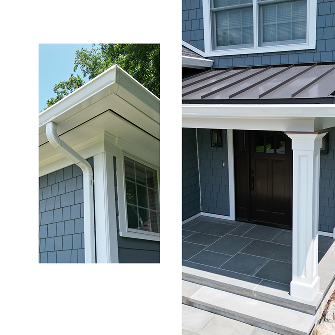Insufficient Ventilation Is Causing your Roof to Fail
Insufficient ventilation in a home can cause various issues, especially with the roof. When there is inadequate ventilation in a house, it causes excess moisture build up in the attic, which can lead to various problems.

As a homeowner you may wonder, how do I know if my home has insufficient ventilation? Here are some some ways insufficient ventilation will present itself:
Visible Moisture on plywood: When warm, moist air from inside the home rises and enters the attic, it can condense and accumulate on the underside of the roof deck. Wet wood in your attic is a red flag. This occurs from bathroom steam, kitchen appliances, plants, laundry rooms and other
Look for beaded water, condensation on hard surfaces, water stains or rusted nails/rust stains on wood. Moisture in the attic can lead to several consequences including mold growth, corrosion of fasteners, staining of wood sheathing, and damage of the roof deck.
- Excessive Heat in the attic: In warmer climates, insufficient ventilation can cause the attic to become extremely hot, which can cause the shingles to deteriorate. This increased heat can also cause the roofing materials to warp and buckle. Your ideal winter attic temperature is similar to outdoor temperatures.
- Mold or Mildew: If mold or mildew is present, this can impact you and your family’s respiratory heath, deteriorate your plywood, drywall and other materials in your attic. Mold is visible in discolored patches. These discolored patches will be white, green-black, gray, orange,pink or black.
- Reduced energy efficiency: Without proper ventilation, hot air can become trapped in the attic, making it more difficult for the HVAC system to regulate the temperature inside the building. This can cause the HVAC system to work harder, which will increase energy costs.
- Ice dams: In colder climates, when the heat from the building rises into the attic, it can cause the snow on the roof to melt. This melted snow can then refreeze when it reaches the colder eaves on your roof, creating ice dams. Ice dams can damage the roof and cause water to back up under the shingles, leading to leaks. To learn more about Ice Dams read our Ice Dam Prevention Blog.
When having the roof replaced on your home, you are making an investment into your home; the comfort and protection of yourself and your family. When you have the chance to have your roof replaced, you want to make 100% sure the roofer is addressing all your roof details along with all the ventilation details.
If you have a new roof installed without proper ventilation, it’s just as good as throwing money down the toilet. That may sound harsh, but very true! Let us explain. We often witness new roofs, some not even 8 months old, start to grow mold due to improper ventilation. This is why we stress the importance of proper ventilation.
Having your roof repaired down the line is an option, however it could be too late (where severe mold and roof rot has formed). A repair will also break up your decking, never remaining true to its original form.
Prevention
To prevent these issues, it is essential to have a professional roofer inspect your roof to ensure that your home is properly ventilated. This is achieved through the use of vents, fans, and other ventilation systems that allow air to circulate through the attic and prevent excess moisture buildup. By addressing ventilation issues, you can help prolong the lifespan of your roof and prevent costly repairs in the future.

The Novalis Difference
When one of our in-house assessors comes by a home without adequate ventilation, we address the situation first assessing and taking real time photos of the roof and roof decking inside your attic, then come up with a solution fitting for your home and budget. We catch many roofs who do not have ventilation in their attic at all, have blocked soffits, incorrect direction of pipe exhaust,. If we spot damage on your roof, depending on the severity of the situation, we will repair your roof or recommend a replacement.
Consider us the scientists of roofing; we have a formula for a balanced ventilation system, using Ventsure intake air from Owens Corning. This means having 50% intake air, preferably 25% on each side of the attic where your soffits are and 50% exhaust at the top ridge vent . Once our assessor is up there, they can determine the balanced air ventilation in your attic along with a tool that can read how much humidity is up there.

In a properly ventilated attic, the outside air will come into the attic through the soffits or intake ventilation, move through the attic, and exit through the exhaust ventilation.






